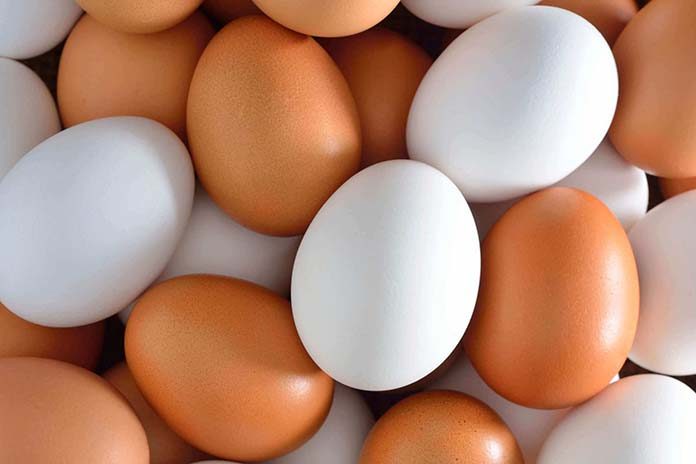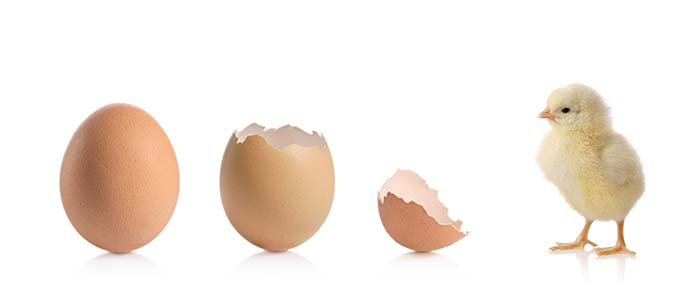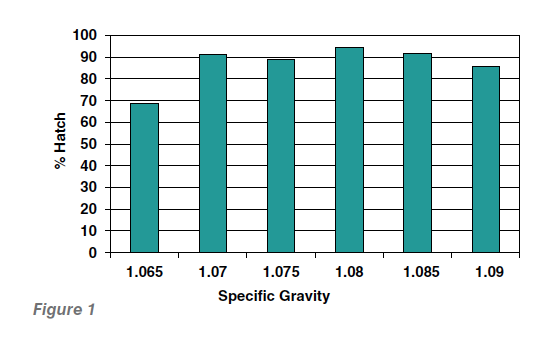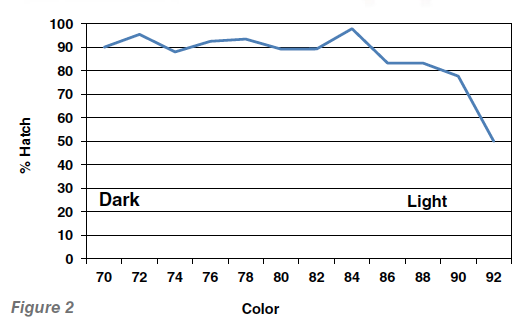
Maintaining egg shell quality is important for maximizing production of broiler chicks from breeders as shell quality and hatchability go hand in hand. Thin shells allow for higher water vapor loss during incubation resulting in dehydrated chicks and higher late embryonic mortality.
Also, egg shells that are thin crack easily during collection and transportation, resulting in poor hatches and higher losses of chicks, from both contamination and excessive moisture loss. The major factors that influence egg shell quality are genetics, diet, climate, housing and age of the hens. Therefore, current knowledge of a flock’s shell quality allows for better management of that flock by changing management practices to improve poor egg shell quality and subsequent hatchability and chick quality.
Of the different measures of egg shell quality, egg specific gravity is the easiest and most widely utilized method. Specific gravity is used to measure egg shell thickness and, indirectly, the percentage of shell deposited on the egg. There are two methods to obtain egg specific gravity, the Archimedes method and the salt solution method. The Archimedes method involves weighing eggs individually, then weighing them in water and then using the formula; [dry weight/(dry weight-wet weight)]. The salt bath method utilizes several tubs of salt water containing graduated levels of salt solution.
For the salt bath method, eggs are placed in the lowest solution and those eggs that do not float are removed and placed into the next higher salt solution, and so forth until the egg floats. The specific gravity of the solution in which the egg floats is the specific gravity of the egg. This method allows for rapid measurement of large numbers of egg, with minimal affect on the eggs. The best time to measure specific gravity is in the hatchery after the eggs have had a chance to reach the same temperature as the prepared salt solutions.

Specific gravity and hatch
To investigate the relationship between hatchability and specific gravity in modern broiler breeders 1,944 eggs were measured for color and specific gravity, with each egg labeled so that every egg could be followed through to hatch. Eggs came from five different flocks of hens in prime production with flock ages between 33 and 45 weeks of age. Salt solutions were maintained in the egg storage room at a local commercial hatchery and measured after they had time to adjust to the temperature of the room. The salt solutions were check regularly for accuracy with a hydrometer and specific gravity ranged from a low of 1.065 to a high of 1.090 in increments of 0.005. Once eggs were measured they were placed with the rest of the eggs from that flock and hatched at the hatchery using industry standards. After hatch, a residue breakout was preformed on all unhatched eggs to determine fertility and time of embryonic mortality.

The hatch results are shown in Figure 1. These results indicate that eggs with a specific gravity of 1.070 hatch as well as those with higher specific gravities and that hatch was not negatively affected until specific gravity was 1.065 or lower. These results are different than those published by McDaniel et al., 1981 and Bennett, 1992, who report that eggs with specific gravities less than 1.080 had poor hatch and increased embryo mortality. The difference in results may be the result of genetic progress and changes made during the last 20 years, or in experimental methodology.
Shell color and hatch
Over the years it has often be assumed the light colored eggs in broiler breeders do not hatch as well as darker eggs. Therefore in the previously mentioned experiment we also recorded the egg shell color for each egg using a colorimeter that gave a numeric measurement of the shell color. By using a colorimeter we were able to remove humane error from trying to determine the shell color. The colorimeter produced high numbers for whiter eggs while darker eggs had lower numeric values.

Figure 2 shows the relationship of specific gravity to shell color. These results show that the hatch of extremely light colored eggs is lower than the darker eggs. This is expected as broiler industry practices have always been to ‘not set white eggs’. From this study, the light-colored eggs that did tend to suffer hatch problems, were those that producers typically should cull anyway. The excessively light eggs may be caused by a dietary problem or environmental stress. As the shell pigment is applied to the egg shell just prior to the egg being laid this may be a sign of prematurely laid eggs. Interestingly, eggs with a lighter shell color also tend to have lower specific gravity. This is not a constant for each egg, but as a collective group, eggs with low specific gravity tend to have lighter colored shells as well.
Summary
Specific gravity can be effectively used to rapidly evaluate the egg shell quality in broiler breeders, however, it is a procedure that can be time consuming. Eggs with specific gravity values higher than 1.070 will have similar hatchability while those with lower values will result in reduced hatchability. And lighter colored eggs (color scores above 87) hatched at a lower rate than did darker eggs. However, other than the excessively light eggs, eggs shell variation within a group of was not necessarily a negative factor towards hatchability.

















